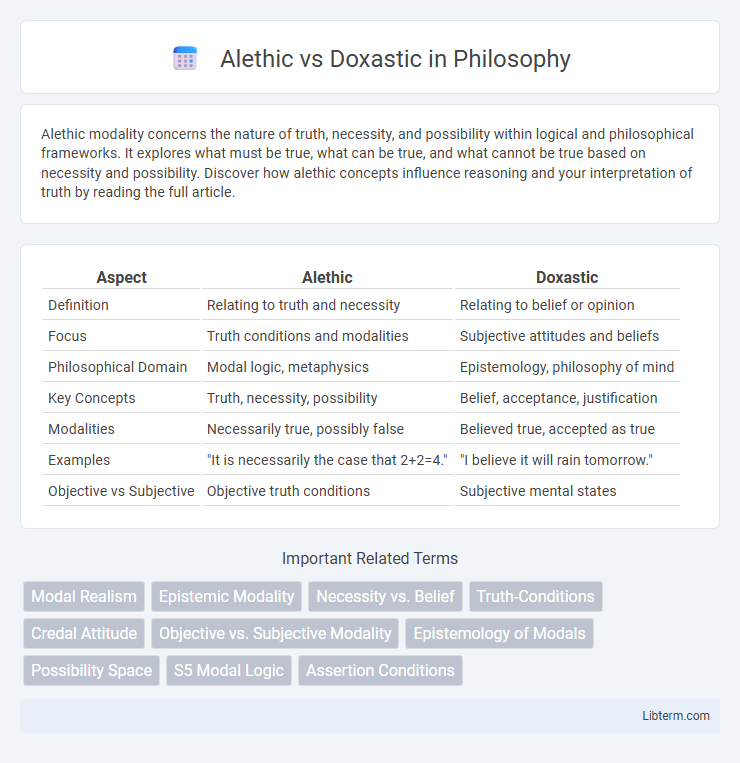Alethic modality concerns the nature of truth, necessity, and possibility within logical and philosophical frameworks. It explores what must be true, what can be true, and what cannot be true based on necessity and possibility. Discover how alethic concepts influence reasoning and your interpretation of truth by reading the full article.
Table of Comparison
| Aspect | Alethic | Doxastic |
|---|---|---|
| Definition | Relating to truth and necessity | Relating to belief or opinion |
| Focus | Truth conditions and modalities | Subjective attitudes and beliefs |
| Philosophical Domain | Modal logic, metaphysics | Epistemology, philosophy of mind |
| Key Concepts | Truth, necessity, possibility | Belief, acceptance, justification |
| Modalities | Necessarily true, possibly false | Believed true, accepted as true |
| Examples | "It is necessarily the case that 2+2=4." | "I believe it will rain tomorrow." |
| Objective vs Subjective | Objective truth conditions | Subjective mental states |
Introduction to Alethic and Doxastic Modalities
Alethic modalities concern necessity, possibility, and impossibility related to truth, often formalized in modal logic to analyze what must be or could be true. Doxastic modalities deal with beliefs and degrees of certainty, representing what agents believe to be necessarily or possibly true. Understanding alethic versus doxastic modalities clarifies distinctions between objective truth conditions and subjective belief states in epistemic contexts.
Defining Alethic Modality: Necessity and Possibility
Alethic modality concerns the notions of necessity and possibility within logical frameworks, defining what must be true or what can be true based on fixed truths or laws. Necessity in alethic modality refers to propositions that hold true in all possible worlds, whereas possibility refers to propositions that hold true in at least one possible world. This contrasts with doxastic modality, which relates to beliefs or knowledge states rather than objective truth conditions.
Understanding Doxastic Modality: Belief and Opinion
Doxastic modality pertains to expressions of belief, opinion, or knowledge held by an individual or group, reflecting subjective mental states rather than objective truths. This modality is crucial in linguistics and philosophy for analyzing how speakers convey certainty, doubt, or assumption about propositions. Understanding doxastic modality enables deeper insights into communication dynamics, particularly in contexts involving persuasion, argumentation, and epistemic evaluation.
Key Differences Between Alethic and Doxastic Modalities
Alethic modality deals with necessity, possibility, and impossibility concerning truth and reality, emphasizing what must, can, or cannot be true. Doxastic modality, on the other hand, relates to belief states, expressing what a person believes, suspects, or admits as possible or necessary. The key difference lies in alethic modality's objective focus on factual truth conditions versus doxastic modality's subjective focus on mental attitudes toward propositions.
Philosophical Foundations of Alethic vs. Doxastic
Alethic modalities pertain to truth-related concepts such as necessity, possibility, and impossibility, grounded in the philosophy of logic and metaphysics, emphasizing modal operators that express objective truths across possible worlds. Doxastic modalities, on the other hand, relate to belief states and epistemic attitudes, focusing on how knowledge, belief, and justification are represented and analyzed within epistemology. The philosophical foundations of alethic modality rest on semantic theories of truth preservation, while doxastic modality centers on the dynamics of belief revision and rational justification in human cognition.
Semantic Implications in Language and Logic
Alethic modalities concern the notions of necessity and possibility grounded in truth, reflecting statements that are necessarily true or possibly true in all or some interpretations. Doxastic modalities relate to beliefs or degrees of conviction, indicating what an agent believes to be true without guaranteeing truth across all contexts. The semantic implications in language and logic distinguish alethic modality as truth-conditional and context-independent, while doxastic modality depends on the agent's epistemic state, influencing how propositions are interpreted and reasoned about in modal logic frameworks.
Alethic Modal Expressions: Examples and Usage
Alethic modal expressions convey concepts of necessity, possibility, and impossibility related to truth and logical relationships, such as "must," "cannot," and "possible." These modals are essential in formal logic and philosophy to express statements about what is necessarily true or false, e.g., "It must be the case that 2+2=4." Usage of alethic modals often appears in system specifications, mathematical proofs, and philosophical arguments to delineate certainty and logical entailment.
Doxastic Modal Expressions: Examples and Contexts
Doxastic modal expressions, such as "might," "could," and "must," convey degrees of belief or epistemic commitment rather than absolute truth. They frequently appear in contexts involving uncertainty, hypotheses, or personal beliefs, shaping how knowledge and possibility are communicated. For example, in statements like "She might be at home" or "He must be tired," doxastic modals express the speaker's judgment about likelihood based on available evidence.
Applications in Epistemology and Modal Logic
Alethic modalities, concerning necessity and possibility, are fundamental in modal logic for analyzing truth across possible worlds, enabling rigorous frameworks for necessity, contingency, and impossibility in epistemic reasoning. Doxastic modalities, related to belief and knowledge states, play a crucial role in epistemology by modeling agents' beliefs, knowledge acquisition, and their justificatory statuses within formal systems like doxastic logic. Applications intersect in epistemic modal logic, where alethic and doxastic operators combine to dissect how agents understand necessity versus belief, impacting theories of knowledge, justification, and modal truth conditions.
Conclusion: Significance of Distinguishing Alethic and Doxastic
Distinguishing alethic and doxastic modalities clarifies the difference between necessity and belief, enhancing precision in philosophical and logical analysis. Alethic modality pertains to truth and necessity, while doxastic modality relates to belief and knowledge states, critically impacting epistemology and metaphysics. Recognizing this distinction improves argument evaluation and fosters clearer communication in discourse concerning truth claims versus subjective convictions.
Alethic Infographic

 libterm.com
libterm.com